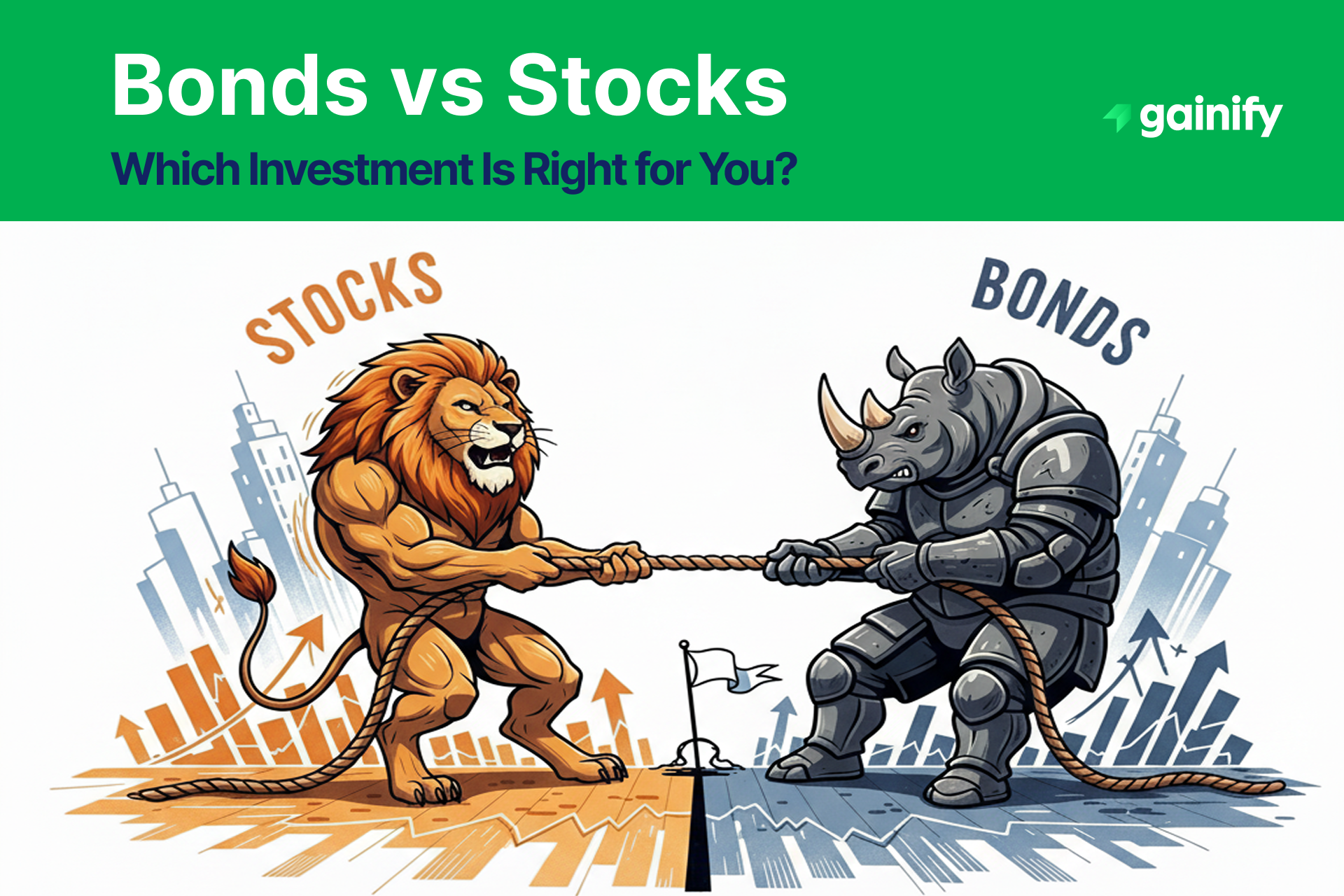For every investor, one of the most fundamental questions is whether to allocate more money into stocks or into bonds. These two investment types form the backbone of global markets, and nearly every investment portfolio in the world is built on some combination of them.
Yet stocks and bonds are very different in structure, behavior, and risk. Choosing between them or deciding how to balance them through asset allocation is one of the most important steps toward reaching long-term financial goals such as building wealth, funding a retirement plan, or saving for education.
At their core, stocks (or shares) represent ownership in a company, traded on platforms such as the New York Stock Exchange or Nasdaq. Stocks allow investors to participate in a company’s profits, but they also expose them to volatility and the risk of loss. On the other side, bonds are debt securities, meaning the investor is a lender rather than an owner. Bonds pay fixed interest payments and return principal at maturity, making them generally more predictable. Bonds are traded in the bond market, which includes both primary and secondary markets, and their risk is measured using bond ratings issued by major credit rating agencies.
The historical record shows that over decades, stocks have provided higher average returns, with the Standard & Poor’s 500 (S&P 500) market index delivering long-term annualized gains of about 9–10 percent. Bonds, by contrast, typically yield 4–6 percent depending on the period. But these figures don’t tell the whole story. Stocks can drop sharply in crises, while bonds often act as stabilizers. In some years, high-quality government bonds rise in value while equity markets fall, providing crucial diversification.
This article explores the debate of bonds vs stocks in depth. We’ll examine how each works, their advantages and disadvantages, how they behave in different economic conditions, and how to blend them in a balanced investment portfolio. Whether you are just starting out or refining a decades-old retirement plan, understanding the strengths and weaknesses of both will help you make better decisions.
What Are Stocks?
Stocks, also known as equity shares, represent ownership in a corporation. Buying a stock makes you a shareholder, entitled to a portion of the company’s profits. These profits may be distributed as dividend stocks, or reinvested to grow the business.
How they trade: Most stocks are listed on major stock exchanges, such as the New York Stock Exchange or Nasdaq. They are highly liquid, meaning investors can buy and sell them daily through brokers in the secondary market.
Returns: Historically, stocks provide the highest returns of mainstream investment types. For example, the Standard & Poor’s 500 (S&P 500) has delivered nearly 10 percent per year on average over the past century. This makes stocks the main driver of long-term wealth creation.
Risks: Stocks are volatile. Share prices fluctuate with company earnings, market sentiment, economic growth, and geopolitical events. A stock can gain 30 percent in one year and lose 20 percent the next. Unlike bonds, there is no guaranteed income, and in the event of bankruptcy, preferred stock and bondholders are paid before equity shareholders.
Types of stocks:
- Common stock: Provides voting rights and potential dividends.
- Preferred stock: Pays fixed dividends and has higher claim on assets than common stock, but usually no voting rights.
- Dividend stocks: Regularly pay out profits to shareholders, offering both income and growth.
- Growth stocks: Companies that reinvest earnings to expand, often with little or no dividend.
For investors building a long-term retirement plan, stocks are essential because of their ability to outpace inflation and compound wealth. But they require patience, since short-term volatility can test even experienced investors.
What Are Bonds?
Bonds are loans made by investors to governments, municipalities, or corporations. When you purchase a bond, you are lending money in exchange for regular interest payments (the coupon) and repayment of principal at maturity.
How they trade: Bonds are issued in the primary market and then bought and sold in the secondary market. The bond market is massive, far larger than the stock market in terms of outstanding value, and it plays a crucial role in global finance.
Types of bonds:
- Government bonds: Issued by national governments, often considered the safest. U.S. Treasuries are the global benchmark.
- Municipal bonds: Issued by states or cities, sometimes offering tax advantages.
- Corporate bonds: Issued by companies, with varying levels of risk.
- Investment-grade bonds: Highly rated by credit rating agencies, considered low risk of default.
- High-yield bonds: Lower-rated bonds with higher yields, but also higher credit risk.
Bond ratings: Agencies like Moody’s, S&P Global, and Fitch assign bond ratings that reflect the likelihood of default. Ratings range from AAA (highest quality) to junk (highly speculative). These ratings guide investors in assessing risk.
Risks: Bonds are less volatile than stocks, but they carry specific risks.
- Interest rate risk: When rates rise, bond prices fall.
- Credit risk: The risk the issuer cannot make payments.
- Inflation risk: Fixed coupons lose purchasing power when inflation is high.
For conservative investors, bonds are valuable because they provide predictable income and stability. They act as the “ballast” in an investment portfolio, offsetting the volatility of equities.
Historical Performance: Stocks vs Bonds
Looking back nearly a century, stocks have outperformed bonds in most long-term horizons.
- U.S. stocks (S&P 500): 9–10 percent average annual returns.
- U.S. Treasury bonds: 4–6 percent average annual returns.
For example, 1,000 USD invested in the S&P 500 in 1980 would now be worth more than 100,000 USD. The same amount in 10-year Treasuries would be worth roughly 15,000–20,000 USD.
But averages mask volatility. During the 2008 financial crisis, the S&P 500 fell 37 percent, while Treasuries gained value. In 2022, both stocks and bonds lost money, but shorter-maturity investment-grade bonds lost far less than equities, protecting capital.
The lesson is that stocks reward patience over decades, but bonds play an essential stabilizing role when markets are under stress.
Risk and Return Comparison
When weighing bonds vs stocks, the key trade-off is between risk and return. Stocks offer the potential for far higher returns, but they come with volatility and uncertainty. Bonds provide predictable income and lower volatility, but their long-term growth potential is capped. Understanding how each behaves allows investors to construct an investment portfolio that aligns with their financial goals and tolerance for risk.
Stocks
1. Return Potential
- Stocks, or equity shares, offer unlimited upside because a company’s growth has no ceiling. If a business expands earnings for decades, shareholders can see exponential gains. Historically, U.S. stocks (as measured by the Standard & Poor’s 500 market index) have delivered around 9–10 percent annualized returns over the past century.
- Stocks are particularly powerful for long-term retirement plans because compounding magnifies growth over decades. For example, dividend stocks reinvest their payouts, creating a snowball effect on wealth accumulation.
2. Volatility and Risk
- Stocks are highly volatile. Prices can rise or fall quickly based on quarterly earnings, macroeconomic news, or shifts in investor sentiment. In recessions, broad equity markets can decline 20–50 percent, testing investor discipline.
- Unlike bondholders, shareholders are last in line during bankruptcy. Preferred stock sits between bonds and common stock, offering priority in dividends and liquidation but still below debt holders.
3. Variations Within Stocks
- Dividend stocks: Provide regular income, reducing reliance on market price appreciation. These can stabilize portfolios by adding cash flow even in downturns.
- Preferred stock: Pays fixed dividends, behaves more like bonds in terms of income, and often has lower volatility than common equity.
- Growth stocks: Offer high potential but often no dividends, making them more volatile.
- Value stocks: Often trade at lower valuations, offering more downside protection but sometimes slower growth.
4. Risks Specific to Stocks
- Market risk: The risk of broad declines across the stock market or a major market index like the S&P 500 or Dow Jones.
- Business risk: The risk a company underperforms peers or fails outright.
- Liquidity risk: Less relevant for large-cap stocks on the New York Stock Exchange, but significant for small-caps or emerging markets where trading volumes are thin.
Bonds
1. Return Potential
- Bonds provide fixed interest payments (coupons) and the return of principal at maturity. Returns are capped by the coupon rate, unlike the theoretically unlimited growth of stocks.
- Historically, U.S. investment-grade bonds have delivered about 4–6 percent annualized returns, less than stocks but higher than cash.
- High-yield bonds (sometimes called junk bonds) can offer 7–10 percent yields but come with greater credit risk.
2. Stability and Risk Profile
- Bonds are typically less volatile than stocks, especially short-term government bonds. They act as the “stabilizers” in a diversified portfolio, providing income and reducing swings in total value.
- Bondholders also have priority in bankruptcy, ranking ahead of shareholders and even preferred stock holders.
3. Bond Ratings and Safety
- Bonds are evaluated by credit rating agencies such as Moody’s, S&P Global, and Fitch.
- Investment-grade bonds (AAA to BBB): Considered safe, with low risk of default.
- High-yield bonds (BB and below): Riskier, but offer higher potential returns.
4. Risks Specific to Bonds
- Interest rate risk: When rates rise, existing bond prices fall. Long-duration bonds are especially sensitive.
- Credit risk: The risk that issuers cannot meet their obligations. Corporate bonds carry higher credit risk than U.S. Treasuries.
- Inflation risk: Fixed coupon payments lose purchasing power when inflation is high.
- Liquidity risk: Some bonds, especially in the secondary market, can be hard to sell at fair value.
The Trade-Off
The trade-off between bonds and stocks is fundamental to asset allocation:
- Stocks drive long-term growth. They are essential for wealth building, beating inflation, and meeting ambitious financial goals like retiring comfortably or passing wealth to future generations.
- Bonds provide stability, income, and diversification. They are critical for reducing portfolio volatility and protecting capital, particularly for investors closer to retirement.
In practical terms, younger investors with long horizons may allocate heavily to equities, perhaps 80–90 percent of their portfolio. As retirement nears, the allocation often shifts toward investment-grade bonds, with 40–60 percent or more in fixed income to prioritize stability and predictable cash flow.
How Economic Conditions Affect Stocks and Bonds: Quick Guide
Economic Condition | Impact on Stocks | Impact on Bonds |
Rising Interest Rates | Growth stocks struggle as borrowing costs rise and future earnings are discounted. | Bond prices fall due to interest rate risk, especially for long-term bonds. |
Falling Interest Rates | Stocks benefit from cheaper credit, often boosting market indexes like the S&P 500. | Existing bonds rise in value as older interest payments look attractive. |
Inflation | Companies with pricing power and dividend stocks may hold up, but margins often shrink. | Fixed-income bonds lose real value, even investment-grade bonds face inflation risk. |
Recessions | Stocks decline as profits fall and investors sell off equities on stock exchanges. | Government and high-rated bonds gain as safe havens, stabilizing retirement plans. |
Boom Periods | Stocks outperform, fueled by strong earnings and rising confidence. | Bonds lag as central banks raise rates, lowering bond prices. |
Portfolio Role: Balancing Stocks and Bonds
Every investor faces the question of how to split between stocks and bonds. This is the essence of asset allocation.
- Stocks: Provide growth, essential for beating inflation.
- Bonds: Provide income and stability, reduce volatility.
The classic 60/40 investment portfolio (60 percent stocks, 40 percent bonds) has been used for decades. Pension funds, endowments, and individual retirement plans have relied on it as a balanced approach. While the exact ratio should be adjusted for age, risk tolerance, and financial goals, the principle remains: combine growth assets with stabilizers.
Younger investors with decades until retirement may choose 80 percent stocks and 20 percent bonds. Retirees may reverse the ratio, prioritizing steady interest payments and capital preservation through investment-grade bonds.
Advantages and Disadvantages
Stocks Advantages:
- Highest long-term return potential.
- Ownership in real businesses.
- Liquidity on major stock exchanges.
- Ability to invest in market index funds tracking the S&P 500 or other benchmarks.
- Dividend stocks provide income.
Stocks Disadvantages:
- High volatility.
- Risk of losing capital in downturns.
- Last in line for repayment in bankruptcy, behind bondholders and preferred stock holders.
Bonds Advantages:
- Predictable interest payments.
- Lower volatility.
- Priority in bankruptcy.
- Wide variety of choices, from safe investment-grade bonds to higher-yielding but riskier debt.
Bonds Disadvantages:
- Lower long-term returns.
- Exposed to interest rate risk and credit risk.
- Inflation erodes purchasing power.
Practical Guidelines for Investors
- Clarify your financial goals. Decide whether you are saving for retirement, education, or wealth accumulation.
- Consider your time horizon. Short-term needs favor bonds. Long-term goals require stocks.
- Assess your risk tolerance. If market swings cause stress, increase your bond allocation.
- Diversify globally. Use international stocks and bonds to spread risk across economies.
- Use bond ratings. Favor investment-grade bonds for stability, but allocate selectively to high-yield bonds if you can tolerate credit risk.
- Include different equity types. Mix growth stocks, dividend stocks, and preferred stock for diversification.
- Rebalance regularly. As markets shift, restore your asset allocation to target weights.
Conclusion
Choosing between stocks vs bonds is not about finding the “better” investment. Both play essential roles in building lasting wealth. Stocks provide ownership in companies and the potential for long-term growth. Bonds deliver steady income and help preserve capital during uncertain times.
The right balance comes down to your goals, time horizon, and comfort with risk. Younger investors may benefit from leaning more toward stocks to maximize growth, while those approaching retirement often increase bond exposure for income and stability.
Markets will always shift — rates rise and fall, inflation comes and goes, recessions alternate with expansions. Through it all, diversification remains the most reliable strategy. By holding both stocks and bonds, investors create portfolios that are more resilient than relying on a single asset class.
Smart investing is less about predicting the future and more about preparation. A thoughtful mix of growth and stability allows you to weather volatility and steadily progress toward your financial future.




